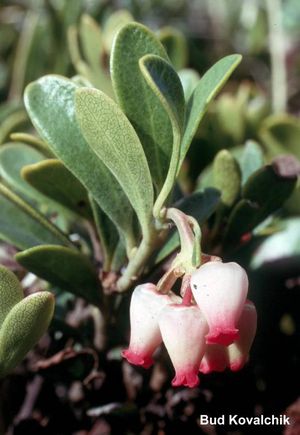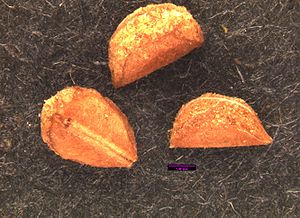Arctostaphylos uva-ursi
- Latin Name: Arctostaphylos uva-ursi
- Family: Ericaceae
- Common Names: red bearberry, kinnikinnik
- Synonyms/Misapplications: Arbutus uva-ursi
- Codon: ARCUVA
Contents
Taxonomy
| Arctostaphylos uva-ursi | |
|---|---|

| |
| Photo by Bernard Kovalchik. Also featured on Main Page | |
| Scientific classification | |
| Kingdom: | Plantae |
| Subkingdom: | Viridiplantae |
| Phylum: | Tracheophyta |
| Subphylum: | Spermatophytina |
| Class: | Magnoliopsida |
| Subclass: | Asteranae |
| Order: | Ericales |
| Family: | Ericaceae |
| Genus: | Arctostaphylos Adans. |
| Species: | Arctostaphylos uva-ursi (L.) Spreng |
Description
General: Shrub; stems trailing across ground, less than 2 dm tall. Leaves: Alternate, 1-3 cm long, dark green, leathery, rounded at tip. Flowers: Light pink urn-shaped flowers in small clusters near tips of stems. Fruit: Bright red round berries 7-10 mm in diameter.
Prostrate shrub with somewhat stoloniferous rooting stems sometimes forming mats several meters wide; bark reddish to brownish, peeling off; stems ascending at the tip, 5-15 cm tall, minutely hairy, sometimes glandular. Leaves: Alternate, evergreen, leathery, egg- to spoon-shaped, 1-3 cm long, 0.3-1.2 cm wide, rounded at tip, rarely pointed, narrowed basally; entire, glabrous to minutely hairy especially on the margins and midrib, dark green above, paler below; stalks 2-5 mm long. Flowers: several in few-flowered terminal clusters; flower stalks 2-5 mm long, straight or curved, borne in the axils of hairy bracts; corollas pinkish-white, urn-shaped, 4-6 mm long, five lobed; clayces 1-1.5 mm long. Berries, bright red, 5-10 mm wide.[1]
Bloom Period
April - June[2]
Distribution
Alaska south to California and New Mexico, east to the Atlantic Coast; also in Eurasia.[2]
Habitat
Ecological Setting-Coastal bluffs and prairies, rocky balds, dry subalpine meadows, and dry coniferous forest. Soil Texture-Medium and coarse textured soils Nutrients-Nitrogen poor soils.[3] Soil Reaction / Salinity-5.5-8.0 pH – medium salinity Moisture Regime Low moisture use – high drought tolerance Shade Tolerance Intermediate shade tolerance Successional Status-Common in open canopy in young seral lodgepole pine forests.[4]
Uses
Propagation
Seed
Seed sample from: 2009
Average Measurement: 3.9 x 2.3 x 1.8
Measurement Range: L: 3.75 - 4, W: 2.1 - 2.5, D: 1.5 - 2.25
Features
Shape: Fruits segmented with seeds like an orange. Individual seeds are orange segment shaped.
Color: Seeds brown. Hilum is a small brown dot on the ridge where the two flat planes of the segment come together.
Surface: Seed mostly smooth. Rounded surface of seed is ridged. It has a slight sheen on the flat planes.
Latitudinal Cross Section: triangular ![]()
Longitudinal Cross Section: elliptical ![]()
Basic Explanations and Assumptions:
The dimensions for the seeds are length x width x depth. The location of the hilum is used as the base of the seed, and the length is measured from hilum to the opposite apex. Where a style is present, the length is measured from the hilum to the bottom of the style. Width is measured at a right angle to the length at the widest part. Depth is measured at a right angle to the intersection of height and width lines.
Measurements included are the mean average for each measurement of ten separate seeds.
All measurements in millimeters unless otherwise noted.


